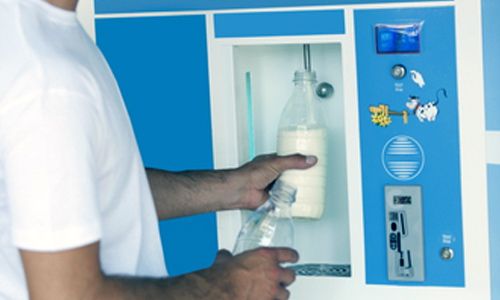
Europe Installs Raw Milk Vending Machines While U.S. Rules Unpasteurized Dairy Illegal

As the U.S. government continues to issue warnings regarding raw dairy products, several European countries have done just the opposite by expanding access through unpasteurized milk vending machines, according to Wake Up World.
Photo courtesy of Shutterstock
Compared with pasteurized and homogenized dairy, the news source argues that raw milk offers a wealth of nutrition—all without the drawbacks of oxidized fats, denatured proteins, antibiotics or growth hormones typically found in pasteurized and processed milk products.
Given the purported benefits of raw milk, multiple European nations have installed self-service vending machines that provide 24-hour access. Michel Cantaloube, who helped introduce the machines in France, the UK and Spain, hopes to expand the venture into a similar vending machine for raw yogurt.
Other countries like Italy, Slovenia, Austria, Switzerland and the Netherlands have begun to install their own raw milk vending machines as well.
However, the U.S. Food and Drug Administration (FDA), tells a different story.
The FDA has listed raw milk’s potential mild to severe effects and issued the following warning:
- Vomiting, diarrhea and abdominal pain
- Flulike symptoms, such as fever, headache and body ache
While most healthy people will recover from an illness caused by harmful bacteria in raw milk—or in foods made with raw milk—within a short period of time, some can develop symptoms that are chronic, severe or even life-threatening.
If you or someone you know becomes ill after consuming raw milk or products made from raw milk–or, if you are pregnant and think you could have consumed contaminated raw milk or cheese—see a doctor or healthcare provider immediately.
In response, Wake Up World questioned the FDA’s stance and pointed to a recent study that indicated children who drank raw milk were 40 percent less likely to come down with asthma or allergies.
A Campaign for Real Milk, an advocacy group associated with the Weston A. Price Foundation and Farm to Consumer Legal Defense Fund, agrees, stating raw milk:
- Protects against infections, diarrhea, rickets, scurvy, tooth decay and tuberculosis
- Demonstrates better child growth profiles with longer and denser bones
- Improves vitamin A, B6 and D absorption
- Enhances mineral assimilation through the presence of lactobacilli
- Individuals diagnosed with lactose intolerance are often able to consume raw milk products without issue
Moreover, hundreds of testimonials support the value of raw milk in helping childhood behavioral problems, digestive disorders, failure to thrive in infants, arthritis, osteoporosis and cancer.
Despite Europe’s emerging stance on raw milk, U.S. health professionals say organic milk and non-dairy options are the best option for Americans, especially since raw milk is illegal in most states.
Here are some basic guidelines for Americans:
- Buy USDA certified organic milk, but read the label.
- The best organic milk available nationwide in stores is from grassfed cows or goats. It doesn’t contain artificial vitamins, nutrients created through mutagenesis or synthetic ingredients. Organic Consumers Association recommends Organic Valley’s Whole Milk Grassmilk.
- The organic milk with the highest level of animal welfare comes from Animal Welfare Approved farms. Unfortunately, few farms are certified to this standard.
- The best non-dairy milk is organic hemp milk. Organic Consumers Association recommends Manitoba Harvest’s Hemp Bliss.
Visit EcoWatch’s FOOD page for more related news on this topic.

 233k
233k  41k
41k  Subscribe
Subscribe 

